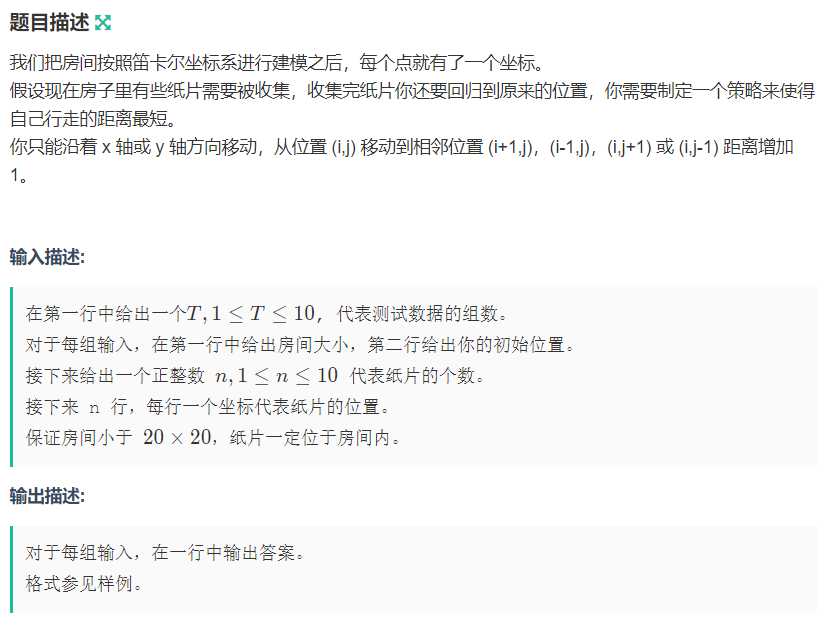标签:图片 int start amp 小白 bfs http 技术 int 题目

考察点 : 全排列,对数据范围的估计程度
坑点 : 注意算最后回到初始的那步距离一看题目最短路,诶呦,这不是最拿手的 BFS 走最短路吗?哈哈,定睛一看
这么多目的地,这还走个茄子,但是看看这道题的数据范围, 10,这不就完完
全全的可以暴力一发了,怎么暴力呢 ?
我们并不知道那条线路会是最优的,所以我们可以用全排列列举出每一条线路,
然后最后取最小值即可。#include <cstdio>
#include <string>
#include <cstring>
#include <iostream>
#include <algorithm>
#define INF 0x3f3f3f3f
#define x first
#define y second
using namespace std;
const int maxn = 25;
typedef pair<int,int>PII;
int T,n,res;
int start_x,start_y,end_x,end_y;
int a[maxn];
PII P[maxn];
int main(void) {
int dist(int x,int y);
void solve();
scanf("%d",&T);
while(T --) {
scanf("%d%d",&end_x,&end_y);
scanf("%d%d",&start_x,&start_y);
scanf("%d",&n);
for(int i = 1; i <= n; i ++) {
scanf("%d%d",&P[i].x,&P[i].y);
}
P[n + 1].x = start_x,P[n + 1].y = start_y;
res = INF;
solve();
printf("The shortest path has length %d\n",res);
}
return 0;
}
int dist(int ax,int ay,int bx,int by) {
return abs(ax - bx) + abs(ay - by);
}
void solve() {
// 拿 a 数组的不同排列作为我们走的每条线路
for(int i = 1; i <= n; i ++) {
a[i] = i;
}
do {
int ans = 0;
for(int i = 1; i <= n; i ++) {
if(P[a[i]].x > end_x || P[a[i]].y > end_y) continue;
if(i == 1) ans += dist(start_x,start_y,P[a[i]].x,P[a[i]].y);
else ans += dist(P[a[i]].x,P[a[i]].y,P[a[i - 1]].x,P[a[i - 1]].y);
}
// 回到起点
ans += dist(start_x,start_y,P[a[n]].x,P[a[n]].y);
res = min(res,ans);
} while(next_permutation(a + 1,a + 1 + n));
return ;
}一定要观察数据范围,根据数据范围采取对应的策略标签:图片 int start amp 小白 bfs http 技术 int 题目
原文地址:https://www.cnblogs.com/prjruckyone/p/12354295.html